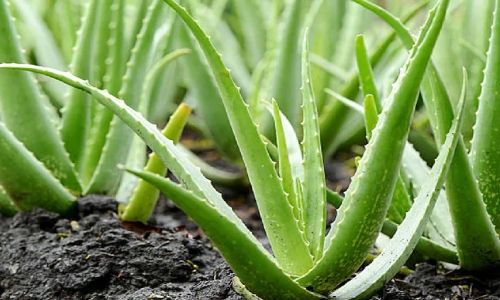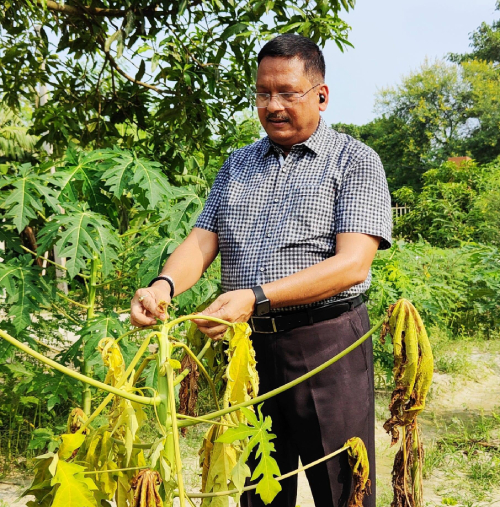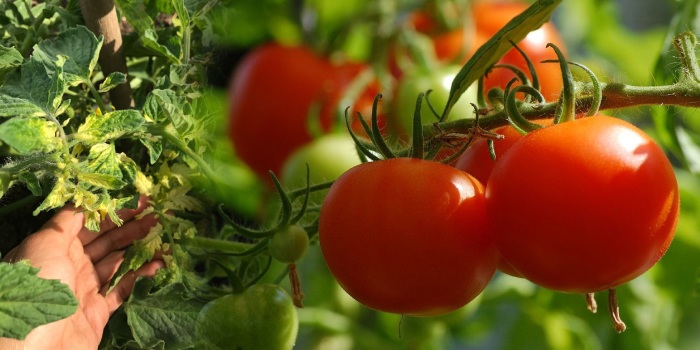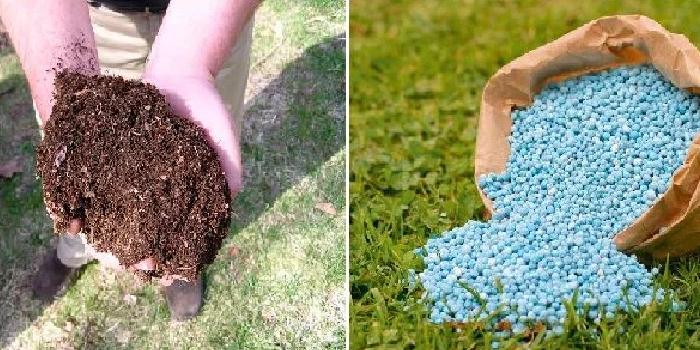
Topic: Commercial cultivation of Aloe Vera
Introduction
Aloe Vera, scientifically known as Aloe barbedensis. It belongs to family Liliaceae and it is native to North Africa. Rajasthan, Andhra Pradesh, Gujrat, Tamil Nadu, Maharashtra, Kerala are major producers of Aloe Vera. Aloe Vera which is locally known as Ghrit Kumari and ghikanwar has many health benefits and use for skin treatments, and to treat several diseases like heart diseases and digestion issues. Aloe Vera becomes popular due to its medicinal properties and it is known as “miracle plant”. Name of Aloe Vera is derived from Arabic “alloeh” mean bitter due to presence of bitter substance in leaves while “vera” in latin means “true”. There are 150 species of Aloe Vera but only one variety that has a medicinal value dating back to thousand of years. Major producers of Aloe Vera are Africa, China, USA, Australia, Coastal areas of South India.
History
Aloe vera has been used for medicinal purpose in several countries such as Greece, Egypt, Mexico, India, Japan, China. Egyptian queens Nefertiti and Cleopatra used it as apart of their regular beauty regimes. Alexander the Great and Christopher Columbus used it to treat wounds. The first reference to Aloe vera in English was a translation by John Goodyew in A.D. 1655 of Dioscorides’ Medical treatise De Materia Medica. By the early 1800s, Aloe vera was in use as a laxative in the United States, but in the mid-1930s, a turning point occurred when it was successfully used to treat chronic and severe radiation dermatitis.
Plant anatomy
Aloe Vera is hardy, perennial tropical plant. The plant has triangular, fleshy leaves with serrated edges, yellow tubular flowers and fruits that contain numerous seeds. Each leaf is composed of three layers
1. An inner clear gel that contains 99% water and rest is made of glucomannans, amino acids, lipids, sterols and vitamins.
2) The middle layer of latex which is the bitter yellow sap and contains anthraquinones and glycosides.
3) The outer thick layer of 15–20 cells called as rind which has protective function and synthesizes carbohydrates and proteins. Inside the rind there are vascular bundles responsible for transportation of substances such as water and starch.
It is coarse looking, shallow rooted with a short stem 30-60 cm high. Multiple tuberous roots and many supporting roots penetrating into soil. The grow close to the ground in a typical rosette shape. The fleshy leaves are densely crowded, strongly cuticularized and have a spiny margin.
Uses of Aloe Vera
Aloe Vera is used in cosmetic industry for the preparation of shampoo, face cream, shaving cream, moisturizers. It is also used in pickles and vegetables. To treat fever, enlarged liver, spleen and other glands Aloe Vera is used. It is used to treat Gonorrhoea, Constipation, menstrual suppressions, piles, jaundice, rheumatic disease, and also for the treatment of burns and bruises.
Health benefits of Aloe Vera
1. It is used as and antibacterial, antiviral, antibiotic, antifungal, antiseptic, germicidal.
2. To treat skin diseases
3. To treat urine treated problems, ulcers, pimples.
4. It is good source of vitamin and minerals.
5. It is a well-known adaptogen
6. It helps with digestion
7. It helps in detoxification process
8. It is healthy for heart
Cultivation practices of Aloe Vera
1. Soil
• Aloe Vera can be cultivated in a wide range of soil from Sandy to loam soil.
• It thrives best in light sandy soils.
• Soil should be well-drained soil because it is susceptible for water-logging.
• It is suitable in PH up to 8.5
• In black cotton soil, Growth would be faster
• It can tolerate soil with salty nature
• It thrives best with higher foliage
2. Climate
• It is a warm tropical crop.
• It can grow in various climatic condition.
• It can successfully grow in low rainfall region and dry areas with warm humid conditions.
• It is very sensitive to extreme cold condition.
• It can’t tolerate frost and cool climatic condition.
3. Land preparation
• Land can be prepared by ploughing twice before cultivation.
• Remove the weeds thoroughly to reduce the crop-weed competition
• Prepared small canals for the drainage of extra water which is collected in the field
• Apply 15-20 tonnes/hectares of well rotten farm yard manure or cow dung manure during the time of last ploughing is added to increase the soil fertility.
4. Propagation of Aloe Vera
• Aloe Vera can be cultivated through root suckers or rhizome cuttings.
• For the root suckers, select medium size root suckers.
• Carefully plant the root suckers without damaging the mother plant at the base.
• Plant directly in main field.
• For rhizome cuttings, take about 6 cm length cuttings with 2-3 nodes and place on prepared seed beds.
5. Planting
• Once sprouts are popping up, transplant it in the main field.
• 15,000 suckers are required for 1 acre of nursery.
• Required plant to plant distance is 40 cm distance.
• Root suckers or rhizome cuttings are planted in such a way that 2/3 position of root suckers/rhizome cutting should under the ground.
6. Irrigation
• Aloe Vera can grow in both irrigated and rainfed conditions.
• Once sucker is planted in the main field, provide the irrigation immediately.
• For the good yield of the Aloe Vera, provide couple of irrigation in hot summer days.
• In rainy season, avoid water logging in field.
7. Intercultural operations
• Earthing up should be carried out after around 40 days. After applying a top dressing of fertilizer, earthing up is also done.
• Regular weeding is necessary to reduce the crop-weed competition.
8. Manures and fertilizers
• Application of 15 to 20 tonnes per hectare of well rotten FYM or cow dung manure Apply same dose of FYM should be applied every year.
• Apply N:P:K 50:50:50 basally.
9. Harvesting
• Aloe Vera plant is ready for harvesting from second year after planting.
• Picking of leaves can be carried out in monsoon or evening.
• Total 3 harvest can be carried out in one year.
• Aloe vera is labour intensive crop
• The leaves will again regenerate after harvesting up to 5 years after planting of the Aloe Vera.
10. Post Harvesting practices
• After harvesting of the leaves, the crop is allowed to loose moisture in field to prevent the growth of mould.
• Stack and store in concrete floor
11. Aloe vera products
• Skin products- Fresh gel, toner, massage cream
• In food_- juice, jam, pickles, powder, it is used in desserts and yogurts.
12. Economic life and yield
Commercial yield of the Aloe Vera can be obtained from second and fifth year and after the plant is re- planted. Average yield of Aloe Vera is 40-45 tonnes of leaves.
13. Marketing of Aloe Vera
• Aloe Vera plant has great demand in market due to its medicinal properties and aroma.
• Marketing of Aloe Vera should be done by herbal and pharma companies.
• Price of aloe vera in market is around 20 to 25 Rs/kg.
Active components in Aloe Vera
1. vitamins: It contains vitamins A (beta-carotene), C and E, which are antioxidants. It also contains vitamin B12, folic acid, and choline. Antioxidant neutralizes free radicals.
2. Enzymes: It contains 8 enzymes aliiase, alkaline phosphatase, amylase, bradykinase, carboxypeptidase, catalase, cellulase, lipase, and peroxidase. Bradykinase helps to reduce excessive inflammation when applied to the skin, while others help in the breakdown of sugars and fats.
3. Minerals: It provides calcium, chromium, copper, selenium, magnesium, manganese, potassium, sodium and zinc which are essential for the proper functioning of various enzyme systems in different metabolic pathways and few of them are antioxidants.
4. Sugars: It provides monosaccharides (glucose and fructose) and polysaccharides (glucomannans/polymannose). Recently, a glycoprotein with antiallergic properties, called alprogen and novel anti-inflammatory compound, C-glucosyl chromone, has been isolated from Aloe vera gel.
5. Anthraquinones: It provides 12 anthraquinones, which are phenolic compounds traditionally known as laxatives. Aloin and emodin act as analgesics, antibacterials and antivirals.
6. Fatty acids: It provides 4 plant steroids; cholesterol, campesterol, β-sisosterol and lupeol. All these have anti-inflammatory action and lupeol also possesses antiseptic and analgesic properties.
7. Hormones: Auxins and gibberellins that help in wound healing and have anti-inflammatory action.
8. Others: It provides 20 of the 22 human required amino acids and 7 of the 8 essential amino acids.
Varieties of Aloe Vera
1. Aloe perfoliata: Aloe perfoliate also known as the rubble aloe or mitre aloe. It is a hardy creeping aloe, found in rocky, mountainous areas throughout the Western Cape, South Africa.
2. Aloe chinesis: Aloe chinensis is one of the most famous and easy to care for varieties of the Aloe genus.
3. Aloe litoralis: Aloe littoralis is a succulent that forms a rosette at the top of an upright, usually unbranched stem densely bearded with old dry leaves.
4. Aloe abyssinia: Leaves densely rosulate, ensiform, deep green, often spotted when young, 1 1/2–2 ft. long, 3–4 in. broad low down; marginal teeth large, deltoid, tipped with brown.
Side effects of Aloe Vera
Topical: It may cause redness, burning, stinging sensation and rarely generalized dermatitis in sensitive individuals. Allergic reactions are mostly due to anthraquinones, such as aloin and barbaloin. It is best to apply it to a small area first to test for possible allergic reaction.
Oral: Abdominal cramps, diarrhea, red urine, hepatitis, dependency or worsening of constipation. Prolonged use has been reported to increase the risk of colorectal cancer. Laxative effect may cause electrolyte imbalances (low potassium levels).
Contraindication: Contraindicated in cases of known allergy to plants in the Liliaceae family.
Pregnancy and breastfeeding: Oral aloe is not recommended during pregnancy due to theoretical stimulation of uterine contractions, and in breastfeeding mothers, it may sometime cause gastrointestinal distress in the nursing infant.
9. Interactions: Combined use of Aloe vera and furosemide may increase the risk of potassium depletion. It decreases the blood sugar levels and thus may interact with oral hypoglycaemic drugs and insulin.
Aloe Vera is an excellent plant for cultivation in dry areas and region with less annual rainfall and once planted, it given the yield for 5 years.








